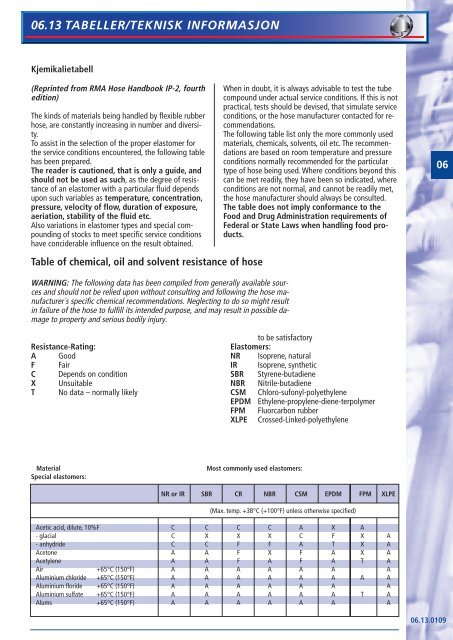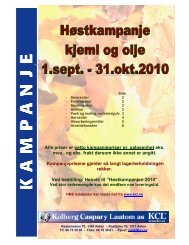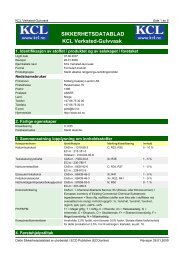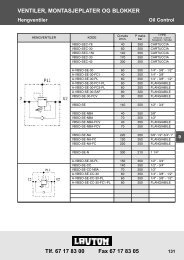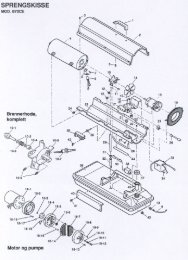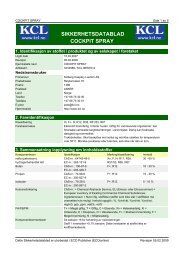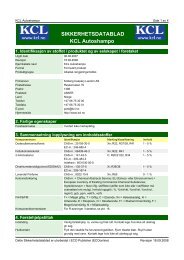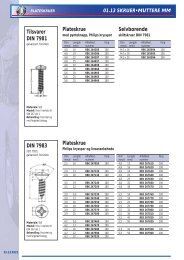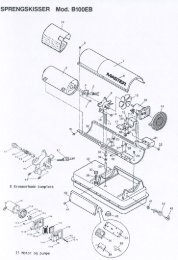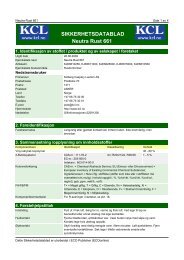06.13 Tabeller/teknisk informasjon
06.13 Tabeller/teknisk informasjon
06.13 Tabeller/teknisk informasjon
You also want an ePaper? Increase the reach of your titles
YUMPU automatically turns print PDFs into web optimized ePapers that Google loves.
<strong>06.13</strong> SLANGER TABELLER/TEKNISK OG KLEMMER INFORMASJON<br />
TUTER<br />
Kjemikalietabell<br />
(Reprinted from RMA Hose Handbook IP-2, fourth<br />
edition)<br />
The kinds of materials being handled by flexible rubber<br />
hose, are constantly increasing in number and diversity.<br />
To assist in the selection of the proper elastomer for<br />
the service conditions encountered, the following table<br />
has been prepared.<br />
The reader is cautioned, that is only a guide, and<br />
should not be used as such, as the degree of resistance<br />
of an elastomer with a particular fluid depends<br />
upon such variables as temperature, concentration,<br />
pressure, velocity of flow, duration of exposure,<br />
aeriation, stability of the fluid etc.<br />
Also variations in elastomer types and special compounding<br />
of stocks to meet specific service conditions<br />
have conciderable influence on the result obtained.<br />
Table of chemical, oil and solvent resistance of hose<br />
When in doubt, it is always advisable to test the tube<br />
compound under actual service conditions. If this is not<br />
practical, tests should be devised, that simulate service<br />
conditions, or the hose manufacturer contacted for recommendations.<br />
The following table list only the more commonly used<br />
materials, chemicals, solvents, oil etc. The recommendations<br />
are based on room temperature and pressure<br />
conditions normally recommended for the particular<br />
type of hose being used. Where conditions beyond this<br />
can be met readily, they have been so indicated, where<br />
conditions are not normal, and cannot be readily met,<br />
the hose manufacturer should always be consulted.<br />
The table does not imply conformance to the<br />
Food and Drug Administration requirements of<br />
Federal or State Laws when handling food products.<br />
06<br />
WARNING: The following data has been compiled from generally available sources<br />
and should not be relied upon without consulting and following the hose manufacturer´s<br />
specific chemical recommendations. Neglecting to do so might result<br />
in failure of the hose to fulfill its intended purpose, and may result in possible damage<br />
to property and serious bodily injury.<br />
Resistance-Rating:<br />
A Good<br />
F Fair<br />
C Depends on condition<br />
X Unsuitable<br />
T No data – normally likely<br />
to be satisfactory<br />
Elastomers:<br />
NR Isoprene, natural<br />
IR Isoprene, synthetic<br />
SBR Styrene-butadiene<br />
NBR Nitrile-butadiene<br />
CSM Chloro-sufonyl-polyethylene<br />
EPDM Ethylene-propylene-diene-terpolymer<br />
FPM Fluorcarbon rubber<br />
XLPE Crossed-Linked-polyethylene<br />
Material<br />
Special elastomers:<br />
Most commonly used elastomers:<br />
NR or IR SBR CR NBR CSM EPDM FPM XLPE<br />
(Max. temp. +38°C (+100°F) unless otherwise specified)<br />
Acetic acid, dilute, 10%F C C C C A X A<br />
- glacial C X X X C F X A<br />
- anhydride C C F F A T X A<br />
Acetone A A F X F A X A<br />
Acetylene A A F A F A T A<br />
Air +65°C (150°F) A A A A A A A<br />
Aluminium chloride +65°C (150°F) A A A A A A A A<br />
Aluminium floride +65°C (150°F) A A A A A A A<br />
Aluminium sulfate +65°C (150°F) A A A A A A T A<br />
Alums +65°C (150°F) A A A A A A A<br />
<strong>06.13</strong>.0109


